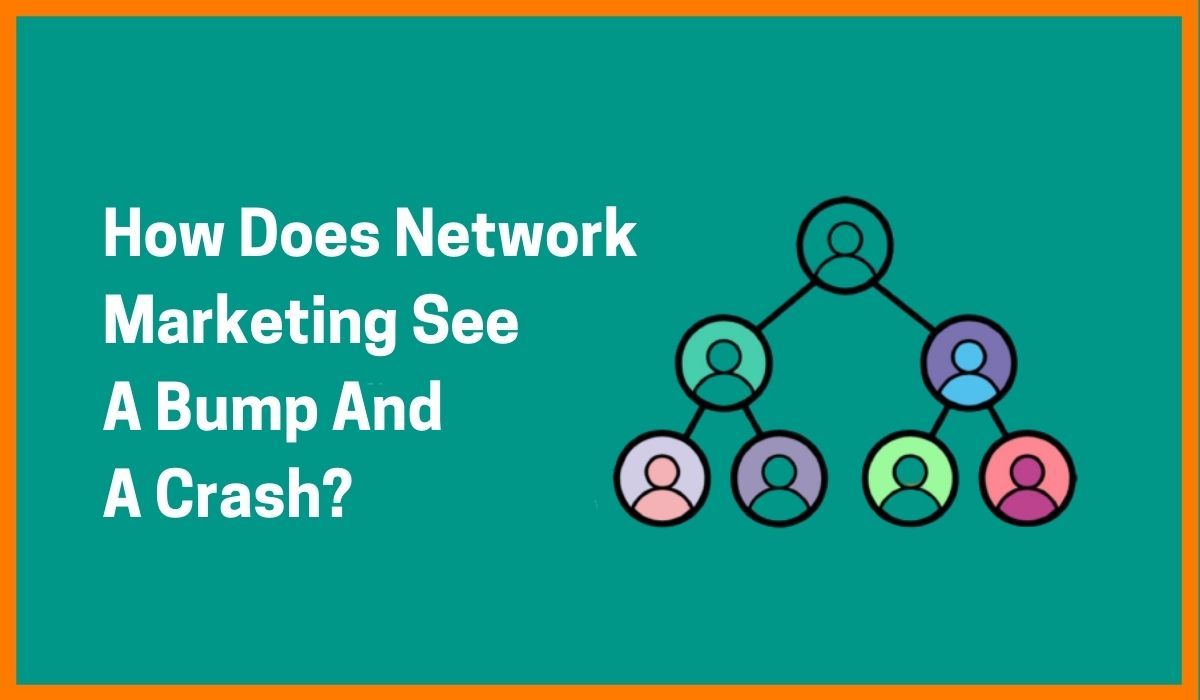How Does Network Marketing See A Bump And A Crash?
Network Marketing
According to a report of the Federal Trade Commission, 99% of all Multi-level Marketing (MLM) or Network Marketing companies fail, surprisingly, these failures come even before the companies have had a chance to flourish a profit.
Network Marketing is a type of business model which depends on person-to-person sales by independent representatives, mostly working from home. Also known as multi-level marketing, it involves a pyramid-shaped network of people who are responsible for the sales of the products. The participants in this network are usually paid on a commission basis for the following tasks like selling a product, their employees make a sale of the product.
This model involves a pyramid structure of non-salaried people who get paid whenever they or a person below them in the pyramid makes a sale. A common example is the Avon commission program in which women sold products for makeup, door to door. Modern examples include marketers who advertise the products of other companies on their own blogs or websites. Let us see the complete story on the topic- How does Network Marketing see a bump and a crash?
Beginning Phase of Network Marketing in India
Growth of Network Marketing in India
The Bump and The Crash
Beginning Phase of Network Marketing in India

Network marketing industry took birth around 1886, with the start of Avon. Direct interaction with customers was greatly successful. Nutrilite in 1945 started an evolution when it came up with MLM compensation plans. In this, the individual representative got the opportunity of establishing their own business by bringing new distributors into the business and earning revenue from their own sales and the sales of the distributors.
When this plan succeeded, global players like Avon, Tupperware, and Amway stepped into international markets of India, Brazil, China in the 1990s .
Network Marketing came to India in the 1980s with companies like Amway, Avon, Oriflame, Modicare, etc. In less than two decades, the direct selling industry has furnished 5 million self-employment opportunities.

Growth of Network Marketing Industry in India

According to the blog post on the topic:- 10 most popular MLM multi-level marketing companies in India by bestwebsiteinindia.com
- More than 1.5 million Amway Business Owners are present just in India.
- Tupperware, Avon come under Fortune 500 companies.
- Modicare has a network of about 2.5 lakh members.
MLM Business revenues were more than 4500 crores in 2015-16 based on the Indian Direct Selling Association report(IDSA).
Future looks promising for Network marketing in India, a report by KPMG in India and FICCI states a whopping growth of ₹645 billion by 2025. It almost doubled in the year 2016 when compared with the year 2011. From the report of Assocham, it is evident that it will touch the record of around 159.3 billion in 2021. The average sale is increasing for each individual, and it is almost about $300 annually.
According to a survey held during the year 2015-16, around 50,000 people gained benefit from the MLM opportunities offered by the direct selling companies. Government schemes like Digital India, Make in India, Skill India motivated the growth of network marketing.
Policies like FDI (Foreign Direct Investment) policy and consumer protection bill will offer a retaining environment for the MLM business.
It has also impacted social and economic factors like the empowerment of Women (around 3.4 million females are distributors of MLM business), Contribution to the Government Sector(helps in improving the Indian economy with its huge revenue), during the year 2013, the tax generated was around INR10 billion, started Social Responsibilities, Network marketing companies have supported social responsibilities. For example, Amway’s Sunrise project and Avon’s Breast Cancer crusade.

The Bump and The Crash
Even with several years of significant increase and contribution in the Indian economy, this industry is considered regardless of the business. This is due to the Ponzi and Money Circulation schemes. Lack of awareness and knowledge makes people fall in scams and blame the whole industry.
In most cases, a low success rate is the byproduct of poor planning or execution, perhaps even both.
Illegal companies were the biggest hurdles in making network marketing success. On 9th September 2016, the Indian Government issued the guidelines to regulate the MLM companies in India. Prior to this, there were 3000+ legal/illegal companies in India. After the regulatory, 90% of fake Ponzi schemes companies were shut.
The following schemes lead to the fall of the Network Marketing industry in India:
1) Pyramid Schemes
A pyramid scheme in Indian law is a scheme where the organizer forms a structure of a pyramid which starts with one person, who represents the tip of the pyramid and subsequently adds the levels below.
Recently, the Reserve Bank of India (RBI) cautioned investors against pyramid scheme fraud, that promise easy or quick money upon enrolment of members. The RBI advised that the public should not be tempted by promises of high returns offered by multi-level marketing companies, that run network marketing.
2) Money Circulation Schemes
A money circulation scheme is defined as any scheme which assures quick and easy earning money through money chain or if someone demands money from another in order to invest it into a money circulation scheme. Money Circulation Schemes or money chain business are not legal in India.
3) Ponzi Schemes
A Ponzi Scheme is a fraudulent investment scheme and is a kind of MLM fraud which promises a high rate of return to its investors.
The cash inflow of the new investors is used to pay returns to old investors. Thus, any problem with the constant flow of investors makes the whole scheme crash. for example, as many as 650 people, especially housewives, were duped of more than Rs 8.16 crore in the nut case fraud in Cyberabad.
The busting of multi-level marketing (MLM) companies fraud by the Cyberabad police resulted in the freezing of Rs 550 crore in bank accounts.
4) Chit Funds
A chit fund is defined as a transaction by or under which a person enters into an agreement with a specified number of persons that every one of them shall subscribe a certain sum of money by way of regular instalments over a definite period.
- Each such subscriber in chit fund shall, in his turn, is entitled to the prize amount.
- The way it works is that a group of people contribute a fixed sum of money after this, any member can draw a lump sum through ways such as a lucky draw.

Conclusion
From the above statistics, details, it can be deduced that the Network Marketing industry has great potential to develop more success in the future of India. Prediction is that will reach around network marketing growth in India 159.3 billion in 2021 and INR645 billion by 2025. It involves 58% of women workforce.
Although choosing a reliable MLM source is crucial otherwise one can easily fall into scams and lose crores of money.
The next time offers an easy business that will change your fortunes, think twice!
FAQs
What is the future of network marketing in India?
Beginning as a part-time job, direct selling has now a proper path in career-building opportunities. In the spam of the last five years, it has emerged as a viable source of income and growth in business marketing. Network marketing growth in India has drastically spiked in recent times.
What is the scope of Network Marketing?
To promote Network Marketing business and direct selling Indian Govt approved 100% FDI Policy. So we can say that the future of network marketing is very good in India and this sector will give lots of jobs opportunity. You can join any best direct marketing companies in India to start extra income.
How many network marketing companies in India?
457 Network Marketing Companies
Must have tools for startups - Recommended by StartupTalky
- Convert Visitors into Leads- SeizeLead
- Website Builder SquareSpace
- Manage your business Smoothly Google Business Suite






